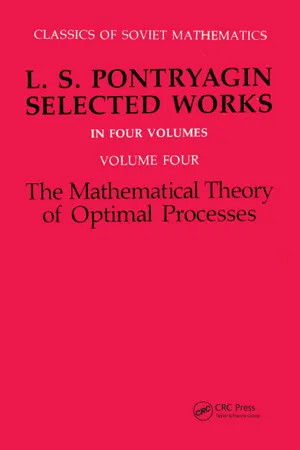
This is a test
- 360 pages
- English
- ePUB (mobile friendly)
- Available on iOS & Android
eBook - ePub
Mathematical Theory of Optimal Processes
Book details
Book preview
Table of contents
Citations
About This Book
The fourth and final volume in this comprehensive set presents the maximum principle as a wide ranging solution to nonclassical, variational problems. This one mathematical method can be applied in a variety of situations, including linear equations with variable coefficients, optimal processes with delay, and the jump condition. As with the three preceding volumes, all the material contained with the 42 sections of this volume is made easily accessible by way of numerous examples, both concrete and abstract in nature.
Frequently asked questions
At the moment all of our mobile-responsive ePub books are available to download via the app. Most of our PDFs are also available to download and we're working on making the final remaining ones downloadable now. Learn more here.
Both plans give you full access to the library and all of Perlego’s features. The only differences are the price and subscription period: With the annual plan you’ll save around 30% compared to 12 months on the monthly plan.
We are an online textbook subscription service, where you can get access to an entire online library for less than the price of a single book per month. With over 1 million books across 1000+ topics, we’ve got you covered! Learn more here.
Look out for the read-aloud symbol on your next book to see if you can listen to it. The read-aloud tool reads text aloud for you, highlighting the text as it is being read. You can pause it, speed it up and slow it down. Learn more here.
Yes, you can access Mathematical Theory of Optimal Processes by L.S. Pontryagin in PDF and/or ePUB format, as well as other popular books in Mathematics & Mathematics General. We have over one million books available in our catalogue for you to explore.
Information
CHAPTER I
THE MAXIMUM PRINCIPLE
§1. ADMISSIBLE CONTROLS
We shall consider the behavior of an object whose state at any instant of time is characterized by n real numbers x1, x2, …, xn (for example, these may be coordinates and velocities). The vector space X of the vector variable x = (x1, …, xn) is the phase space of the object under consideration. The behavior (motion) of the object (from a mathematical viewpoint) consists of the fact that the variables x1, …, xn change with time. It is assumed that the object’s motion can be controlled; i.e., that the object is equipped with certain “controllers” on whose position the motion of the object depends. The positions of the “controllers” are characterized by points u, of a certain control region U, which may be any set in some r-dimensional Euclidean space Er. Giving a point
is equivalent to giving a numerical system of parameters u1, u2, …, ur. In applications, the case where U is a closed region in Er is important. In particular, the control region U may be a cube in the r-dimensional space of the variables u1, u2, …, ur:
(1) |
or any other closed and bounded set in this r-dimensional space. The physical meaning of considering a closed and bounded control region U (in the space of the variables u1, u2, …, ur) is clear. The quantity of fuel being supplied to a motor, temperature, current, voltage, etc., which cannot take on arbitrarily large values, may serve as the control parameters u1, u2, …, ur. In addition, because of the physical construction of the object’s control portion, relations given by one, or several equations of the form ϕ(u1, u2, …, ur) = 0, may exist among the control parameters. In this case, U may have a more or less complicated geometric character. If, for example, there are two control parameters u1 and u2, which, because of the object’s construction, have the form u1 = cos ϕ and u2 = sin ϕ, where ϕ i...
Table of contents
- Cover
- Half Title
- Title Page
- Copyright Page
- Table of Contents
- Editor’s Preface
- Preface to the English Translation
- Introduction
- Chapter I. The Maximum Principle
- Chapter II. The Proof of the Maximum Principle
- Chapter III. Linear Time-Optimal Processes
- Chapter IV. Miscellaneous Problems
- Chapter V. The Maximum Principle and the Calculus of Variations
- Chapter VI. Optimal Processes with Restricted Phase Coordinates
- Chapter VII. A Statistical Optimal Control Problem
- References
- Index